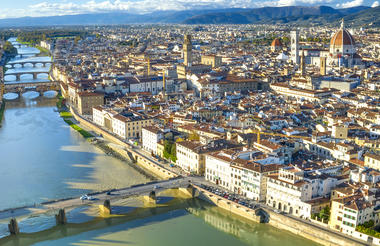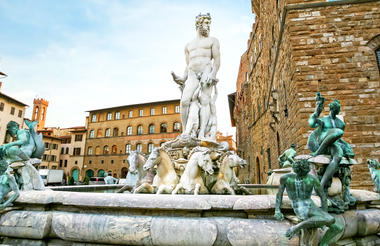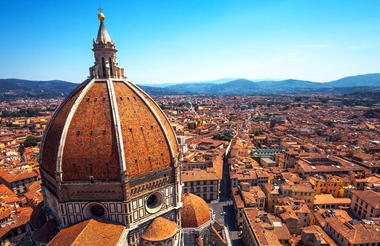Set on a hillside overlooking the Bay of Naples and Vesuvius, Sorrento is a tiny Italian resort town perfectly located for exploring the Amalfi Coast, Capri, Pompeii and the Naples area. However, the little town itself boasts plenty to be discovered. Visitors can enjoy swimming, snorkelling or diving in the sparkling turquoise waters; browsing the maze of shops and stalls full of local craftspeople showing off their skills; or meandering along the unspoiled streets of the old town to discover its wealth of Renaissance palazzi and Romanesque churches. At the heart of the town, the Piazza Tasso perches over a magnificent gorge and is packed with bustling cafes and restaurants serving mouth-watering traditional dishes. The Sorrento locals’ ability to master the fine art of living ‘la dolce vita’ makes Sorrento the ultimate destination for indulgence.



Rome, the capital of Italy’s Lazio Region in the central-western part of the peninsula, is a city that remains virtually unrivalled in the sheer volume and diversity of its cultural repertoire. One could spend months here and still only scratch the surface of treasures to be discovered in this phenomenal ancient city. 3000-odd-years of haphazard urban development has resulted in a complex cocktail of art, history, and architecture full of fascinating cultural clashes and contrasts. Classical ruins as well as countless early Christian catacombs and clandestine churches sit alongside (or beneath) magnificent Renaissance palazzos and breathtaking Baroque fountains. This unique combination of a rich historical tapestry interweaved with a thriving and vibrant modern community living life to its fullest as only the Italians can, makes Italy's Eternal City one of the world's most intriguing and inspiring tourist destinations.



Perched on a hill in the wine region of Chianti, Radda in Chianti is a small but charismatic Tuscan town characterised by a clumsy cluster of beautiful medieval buildings swathed in a sea of vineyards in the Province of Siena, Italy. A stroll along the cobblestone streets leads visitors to centuries-old castles, fortresses, walled gardens, medieval residences and historical sites. Highlights include the Palazzo del Podesta, a 15th-century honey-coloured building that serves as the seat of Radda’s local government, the Neo-Romanesque Church of San Niccolò and The Ice House of the Grand Duke. A visit to the region is incomplete without a self-guided tour at Casa Chianti Classico, a wine museum framed inside an 18th-century convent complex.



The gorgeous capital of Italy’s Tuscany region, Florence, lies towards the centre of the country, a tiny city with a massive heart and an even larger supply of artistic and historical treasures. For centuries, travellers have flocked en masse to the birthplace of the Renaissance movement to marvel at its abundant array of grandiose masterworks of architecture and art. Paramount to any itinerary are Michelangelo’s David, the awe-inspiring Botticelli works, the Uffizi (packed to the brim with pieces by Caravaggio and Da Vinci), and, of course, Brunelleschi’s remarkable cupola, the religious heart of Florence, which dominates the skyline. Once these popular tourist favourites have been ticked off, take a stroll around the alluring Boboli Gardens or climb the hill to the church of San Miniato al Monte to experience enthralling views of this beautiful, beguiling city.



With its spectacular location on the shores of stunning Lake Como, the enchanting northern Italian town of Como has been a popular tourist destination since ancient Roman times. The city’s charming historic centre contains numerous works of art, churches, gardens, museums, theatres, parks and palaces. Spend your days browsing the lovely boutiques and quaint cafes, marvelling at the city’s splendid cathedral, or simply meandering through the bustling Piazza Cavour. The lake and its surrounds are brimming with medieval remnants, ancient stone villages and opulent villas. Picturesque vineyards, olive trees, wisteria vines and breathtaking Alpine peaks are the cherry on top of this idyllic destination. Don’t miss the chance to take a funicular train ride up the mountain to Brunate, to soak up awe-inspiring vistas of the lake and city.



The vibrant metropolis, Milan, it the capital of Italy’s Lombardy region, in northern Italy. Always at the forefront of international fashion, Milan’s sophisticated glitzy facade has afforded it a reputation for superficiality and excessive consumerism. However, beneath its exterior hides a treasure trove of historical and architectural delights: from its glorious Gothic churches, Baroque mansions and Art Nouveau palazzos, to the striking, modern skyscrapers of the Porta Nuova financial district. Must-see sites include the spectacular Duomo Cathedral, the glass-vaulted Galleria, and of course La Scala, one of the world’s most famous opera houses. Milan caters for a broad range of interests: those in search of some glorious designer retail therapy will be well sated, but so too will those looking for fascinating historical sites and remarkable architectural marvels.



Venice is a small, unique city in Italy’s Veneto region, a historical centre consisting of 118 small islands in a lagoon of the Adriatic Sea, linked together by a complex web of canals and footbridges. The stately palaces and ancient churches exist as fascinating remnants of what was once an important trading centre between Europe and the Orient. From the famous Gothic Palazzo Ducale, and the breathtaking Basilica di San Marco to the incomprehensible radiance of Titian's Assunta altarpiece illuminating an entire cathedral, Venice has remained virtually unchanged in the past 600 years. Other must-see attractions include the Bridge of Sighs, the spectacular Peggy Guggenheim Collection (art gallery), fascinating Gallerie dell’Accademia (museum), and of course, gondola rides along the canals.








